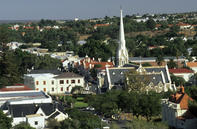Fourth Oldest Colonial Town
Graaff-Reinet is cradled by a generous curve in the Sundays River, at the heart of South Africa's Karoo. It is the fourth oldest colonial town in the country, and has been a favoured outspan destination for centuries.

So hospitality comes naturally to people here. They're warm and friendly, possessing an openness that is born of the immense space surrounding them. Herds of springbok and other game still roam these plains, on family farms cared for by generation after generation. Underfoot lie the fossilized remains of reptiles that roamed the same area 250 million years ago. There is a sense of timelessness here, where the rhythm of seasons dictates the way of life.
Graaff-Reinet, the archetypal Karoo town, is bursting with history: it has the largest concentration of national monuments in the country (more than 50 homes in Cradock Street are national monuments) and one of the most sensational Dutch Reformed churches you'll ever lay eyes on. The town is a feast of gorgeous architecture (not just Cape Dutch) spread out in the magnificent Valley of Desolation.
Defiant History
Named after Governor Cornelis Jacob van de Graaff and his wife, Hester Cornelia Reynet, upon its founding in 1786, this has always been the quintessential Karoo dorp. It is a town with a defiant history, where the local burghers rebelled every time they got gatvol with the lace-necked rulers at the Cape. Some fine examples of period architecture can be found there, and with funding from a local businessman, the late Johan Rupert, some 200 historic buildings have been restored.
The Drostdy Hotel (1806) is the accommodation of choice for bussed-in tourists, so, nice as it is, you might be better off in any one of the many much quieter and equally nice establishments, such as the award-winning Andries Stockenström Guesthouse. Don't miss JH Pierneef's station panels, one of this country's greatest artistic legacies, exhibited at the Pierneef Museum.
Did you know?: Back in 1795, the burghers of Graaff-Reinet – in revolt against exacting regulations enforced by the Dutch VOC company, expelled their landdrost to proclaim a short-lived republic.
 It's a long day, granted, but the only hardship you might endure is the fact that there are no hard parts at all, the trail going as it does...
It's a long day, granted, but the only hardship you might endure is the fact that there are no hard parts at all, the trail going as it does... There are 3 ways out of Nieu Bethesda, but only 2 interest us: Begin at Bethesda Road station, 29 km east of Wilgenbosch hill, near the N9...
There are 3 ways out of Nieu Bethesda, but only 2 interest us: Begin at Bethesda Road station, 29 km east of Wilgenbosch hill, near the N9... Karoo history spans thousands of years and includes the era of Bushman hunter-gatherers and Khoikhoi herders, Huguenot, German and Dutch pas...
Karoo history spans thousands of years and includes the era of Bushman hunter-gatherers and Khoikhoi herders, Huguenot, German and Dutch pas... Graaff-Reinet was founded in 1786 and is the 4th oldest town in South Africa (after Cape Town, Stellenbosch and Swellendam). It was named, b...
Graaff-Reinet was founded in 1786 and is the 4th oldest town in South Africa (after Cape Town, Stellenbosch and Swellendam). It was named, b... This is the land of the springbok, South Africa's national emblem. Once so abundant in this region that herds took three days to pass from s...
This is the land of the springbok, South Africa's national emblem. Once so abundant in this region that herds took three days to pass from s... The dry Karoo was once a vast inland sea. The palaeontologist Andrew Geddes Bain unearthed the fossil of a large jaw filled with teeth which...
The dry Karoo was once a vast inland sea. The palaeontologist Andrew Geddes Bain unearthed the fossil of a large jaw filled with teeth which... When Graaff-Reinet was established in the horseshoe bend of the Sundays River on July 19, 1786, that part of the Karoo was far from peaceful...
When Graaff-Reinet was established in the horseshoe bend of the Sundays River on July 19, 1786, that part of the Karoo was far from peaceful... Panoramic views over mounds of dolerite rocks spike high against the minimalist backdrop of the Great Karoo. Take it in from atop an ancient...
Panoramic views over mounds of dolerite rocks spike high against the minimalist backdrop of the Great Karoo. Take it in from atop an ancient... Four unique old buildings, built in the early 1800’s, house a vast collection of Graaff-Reinet’s rich cultural and natural heritage. Fos...
Four unique old buildings, built in the early 1800’s, house a vast collection of Graaff-Reinet’s rich cultural and natural heritage. Fos...